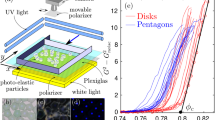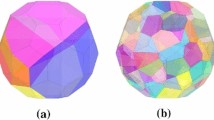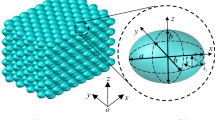Abstract
A 2D ‘Rough Particle’ model consisting of interlocking hexagons is reported. Analytical expressions for the in-plane Poisson’s ratios and Young’s moduli due to particle translation along the geometrically matched male and female interlocks are derived for the model. The dependency of the mechanical properties on each of the model (geometrical and stiffness) parameters is provided, and it is shown that the assembly of interlocking hexagons deforming by particle translation along the interlocks displays auxetic (negative Poisson’s ratio) behaviour. The model predictions are compared with experimental mechanical properties for auxetic polypropylene (PP) films and fibres. The model predicts the experimental Poisson’s ratio values very well (model: νxy = −1.30, νyx = −0.77; experiment (PP films): ν|| = −1.12, \(\nu_{\bot} = -0.77\)). The model generally overestimates the Young’s moduli of the films, but is in reasonable agreement with the axial Young’s modulus of the fibres.














Similar content being viewed by others
References
Evans KE, Nkansah MA, Hutchinson IJ, Rogers SC (1991) Nature 353:124
Gibson LJ, Ashby MF (1988) Cellular solids: structure and properties. Pergamon Press, Oxford
Lakes RS (1987) Science 235:1038
Alderson KL, Evans KE (1992) Polymer 33:4435
Pickles AP, Alderson KL, Evans KE (1996) Polym Eng Sci 36:636
Lees C, Vincent JEV, Hillerton JE (1991) Biomed Mater Eng 1:19
Yeganeh-Haeri Y, Weidner DJ, Parise JB (1992) Science 257:650
Alderson KL, Pickles AP, Neale PJ, Evans KE (1994) Acta Metall Mater 42:2261
Choi JB, Lakes RS (1996) Int J Fract 80:73
Alderson KL, Webber RS, Mohammed UF, Murphy E, Evans KE (1997) Appl Acoust 50:23
Evans KE (1990) Chem Ind 20:654
Caddock BD, Evans KE (1989) J Phys D: Appl Phys 22:1877
Alderson KL, Webber RS, Kettle AP, Evans KE (2005) Polym Eng Sci 45:568
Alderson KL, Alderson A, Webber RS, Evans KE (1998) J Mater Sci Lett 17:1415
Alderson KL, Alderson A, Smart G, Simkins VR, Davies PJ (2002) Plast Rubb Compos 31:344
Ravirala N, Alderson A, Alderson KL, Davies PJ (2005) Phys Stat Sol (b) 242:653
Ravirala N, Alderson KL, Davies PJ, Simkins VR, Alderson A (2006) Textile Res J 76:540
Ravirala N, Alderson A, Alderson KL, Davies PJ (2005) Polym Eng Sci 45:517
Simkins VR, Alderson A, Davies PJ, Alderson KL (2005) J Mater Sci 40:4355. DOI: 10.1007/s10853-005-2829-3
Evans KE, Alderson A (2000) Adv Mater 12:617
Moyers R (1992) US Patent No. 5108413
Stott PJ, Mitchell R, Alderson K, Alderson A (2000) Mater World 8:12
Alderson KL, Alderson A, Davies PJ, Smart G, Ravirala N, Simkins VR (2006) J Mater Sci (in press)
Alderson A, Evans KE (1995) J Mater Sci 30:3319. DOI: 10.1007/BF00349875
Alderson A, Evans KE (1997) J Mater Sci 32:2797. DOI: 10.1023/A:1018660130501
Bathurst RJ, Rothenburg L (1988) Int J Eng Sci 26:373
Wojciechowski KW (2004) In: Tokuyama M, Oppenheim I (eds) Slow dynamics of complex systems. AIP Proceedings
Grima JN, Jackson R, Alderson A, Evans KE (2000) Adv Mater 12(24):1912
Keskar NR, Chelikowsky JR (1992) Phys Rev B 46:1
Grima JN, Evans KE (2000) Chem Commun 1531
Grima JN, Evans KE (2000) J Mater Sci Lett 19:1563
Ishibashi Y, Iwata MJ (2000) Phys Soc Jpn 69:2702
Grima JN, Alderson A, Evans KE (2005) Phys Stat Sol (b) 242(3):561
Alderson A, Evans KE (2002) Phys Rev Lett 89(22):225503-1
Poulter DR (1963) The design of gas-cooled graphite-moderated reactors. Oxford University Press, London
Muto K, Bailey RW, Mitchell KL (1963) Proc Inst Mech Eng 177:155
Alderson KL, Alderson A, Evans KE (1997) J Strain Anal 32:201
Beatty MF, Stalnaker DO (1986) J Appl Mech 53:807
Prall D, Lakes RS (1997) Int J Mech Sci 39:305
Lempriere BM (1968) Am Inst Aeronaut Astronaut 6:2226
Wojciechowski KW (2003) J Phys A: Math Gen 36:11765
Author information
Authors and Affiliations
Corresponding author
Appendix: derivation of aspect ratio of inscribed ellipse within an hexagonal cell
Appendix: derivation of aspect ratio of inscribed ellipse within an hexagonal cell
The inscribed ellipse touches the hexagonal cell edges at S and P (Fig. 4). Taking the origin of the x–y co-ordinate system to be,
the co-ordinates of the hexagonal cell corners Q and R are given by,
The equation of the inscribed ellipse is given by,
where, A and B are the axes of the ellipse aligned along the x and y axes, respectively.
The coordinates of P can be defined in parametric form as,
where, T is any arbitrary angle in space.
However, it is noted from Fig. 4 that B is equal to length SS′. Thus,
It can be observed from Fig. 4 that the slope of the tangent to the ellipse at P is equal to the slope of RQ. Hence,
Since the point P lies on the line QR, the slope of line RQ will be equal to the slope of QP. Thus,
Therefore, from Eqs. A6–A8, the aspect ratio of an ellipse inscribed in the hexagonal cell is,
Rights and permissions
About this article
Cite this article
Ravirala, N., Alderson, A. & Alderson, K.L. Interlocking hexagons model for auxetic behaviour. J Mater Sci 42, 7433–7445 (2007). https://doi.org/10.1007/s10853-007-1583-0
Received:
Accepted:
Published:
Issue Date:
DOI: https://doi.org/10.1007/s10853-007-1583-0




